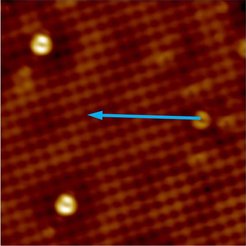Revealing the topological nature of the surface states in SmB6
Topological insulators (TIs) have recently moved into the focus of research in condensed matter physics. Not only did this spark the search for extraordinary physical phenomena, like the observation of Majorana fermions at the TI/superconductor interface, but also completely new concepts for applications can be expected, e.g. in spintronics or quantum computing. The research now published in Science Advances is geared towards the intersection of this relatively new research direction with the more established physics of strongly correlated electron systems, in particular Kondo and heavy fermion physics. In the latter, the insulating properties are brought about by the formation of a narrow hybridization gap below a characteristic temperature, the so-called Kondo temperature TK. It is this small gap that makes the strongly correlated TIs so attractive. On the other hand, such gaps (typically of order 10 meV) call for outstanding energy resolution of the applied experimental techniques.
A hallmark of topological insulators is the robustness of their surface states to the impact of non-magnetic impurities, while magnetic impurities break time reversal symmetry and destroy the surface states. We use scanning tunneling microscopy and spectroscopy on the exemplary Kondo insulator SmB6 and substituted counterparts. Around the impurities – depending on their magnetic properties – the surface state is found to be locally suppressed on different length scales, and for sufficiently high impurity level, globally destroyed. The latter global destruction of the surface state is affirmed by transport measurements. However, introducing magnetic impurities may alter the properties of the underlying Kondo insulating material. To avoid such an impact on the Kondo insulator an alternative approach was pursued: The magnetic entity was not embedded into the SmB6 material, but rather attached to the tunneling tip. Upon using a Cr-coated tip for tunneling spectroscopy on pristine SmB6, a destruction of the signature peak of the topological surface state was again observed, thus revealing a strong impact of magnetism on the surface state. Our results obtained by combining different microscopic with macroscopic probes point directly to the topological nature of SmB6.

Atomically resolved surface of SmB6 substituted with 0.5 at.% Gd (bright spots). The impact of the magnetic Gd on the surface state was investigated by conducting tunneling spectroscopy along positions indicated by the blue arrow.
The local suppression of the surface state around a magnetic impurity follows nicely the prediction by a theoretical model which has been adapted to our case of substituted SmB6. Along with the spin-polarized tunneling results this indicates an exchange interaction driven suppression of the surface state. Taken together, all these results provide clear indications for the long-standing and controversial claim of SmB6 being a topological Kondo insulator. In addition, we suggest a potential application of our findings in single spin detection by using SmB6 as a tunneling tip.
SW / CPfS
